Growing Lemongrass at home is very easy. Learning the conditions lemongrass naturally grows in and then providing similar conditions at home will help the plant thrive. And once the plant establishes – you will never run out of lemongrass! In warm and temperate climates, lemongrass grows perennially, so it is a fantastic plant to sow once and then harvest for years to come. And even in cold climates, lemongrass grows well as an annual. So let’s find out how to grow lemongrass at home.
Lemongrass, also known as Cymbopogon or fever grass is a native of Southeast Asia and an essential herb in many Asian dishes. It is a tropical and subtropical perennial herb with a citrus scent combining tangy lemon with a grassy texture and subtle spice-like quality.
Related: Why Is My Lemongrass Plant Dying? Causes and Solutions | Kaffir Lime Fruit Uses In The Kitchen And Home | Eating Moringa with Recipe Ideas
Table of Contents
- Lemongrass Appearance and Growth Habit
- Lemongrass Varieties
- Lemongrass Growing Conditions
- How To Grow Lemongrass
- Growing Lemongrass In Pots
- How To Propagate Lemongrass
- Can Lemongrass Grow In Water?
- How To Grow Lemongrass From Supermarket
- How Fast Does Lemongrass Grow?
- How To Harvest Lemongrass
- How To Store Lemongrass
- Pests and Disease
- FAQ
- Conclusion
- Recommended Products
Lemongrass Appearance and Growth Habit
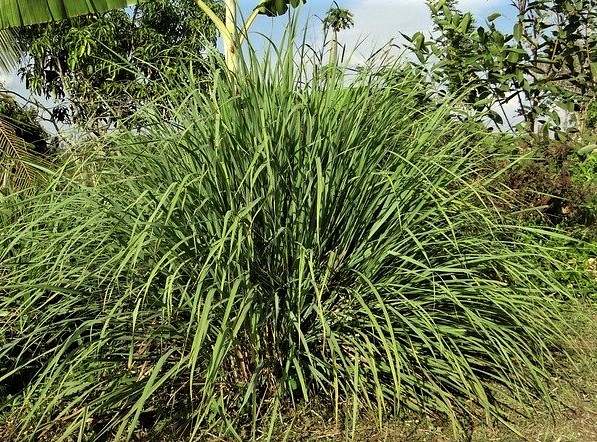
Lemongrass grows and spreads vigorously in clumps with several long stiff stems that are green in color with long sharp grassy blades. For this reason, reasonable care should be taken when harvesting the stalks.
The stalks are a greenish-white color and form the part of the lemongrass plant most often used in Asian dishes, though the leaves are also used – especially for making lemongrass tea.
Lemongrass can grow 3-5 feet tall (1-1.5 meters) and can spread to 4 feet (1.2 meters) wide.
Lemongrass Varieties
There are a number of different varieties of lemongrass. The most commonly grown edible varieties are the West Indian Lemongrass (Cymbopogon Citratus) and East Indian Lemongrass (Cymbopogon Flexuosus).
They both have a fresh, aromatic citrus scent and flavor though the West Indian Lemongrass with its thicker stems is preferable for its culinary uses.
Lemongrass Growing Conditions
As a subtropical plant, lemongrass thrives in a warm and humid climate with temperatures ranging from 50 to 91°F degrees (10°C to 33°C). Lemongrass plants can be grown in cooler climates by overwintering them in a protected environment.
The ideal soil for growing lemongrass is moist and fertile loam soil. Though lemongrass will grow in a range of soils with pH ranging from 5 to 8. You can check your soil with a soil pH gauge.
To provide rich and well-draining soil, amend the soil with compost and well-rotted manure prior to planting.
Lemongrass grows best in full sun or partial shade. For a healthy plant, position lemongrass in the garden or a pot to receive at least 6-8 hours of sunlight a day.
Although lemongrass can be relativity drought tolerant, regular watering will encourage strong, healthy growth. Lemongrass is a subtropical and tropical plant where it grows in humid conditions with regular rainfall. During winter and the plant’s dormant state, water should be reduced.
As a general rule of thumb, it’s a good idea to allow the top 1 inch of soil to dry out between watering – though, below this, the soil below should remain moist. You can check the soil with your finger or use a water gauge.
Healthy lemongrass also benefits from the addition of nitrogen fertilizer, such as chicken manure pellets and liquid seaweed fertilizer.
How To Grow Lemongrass
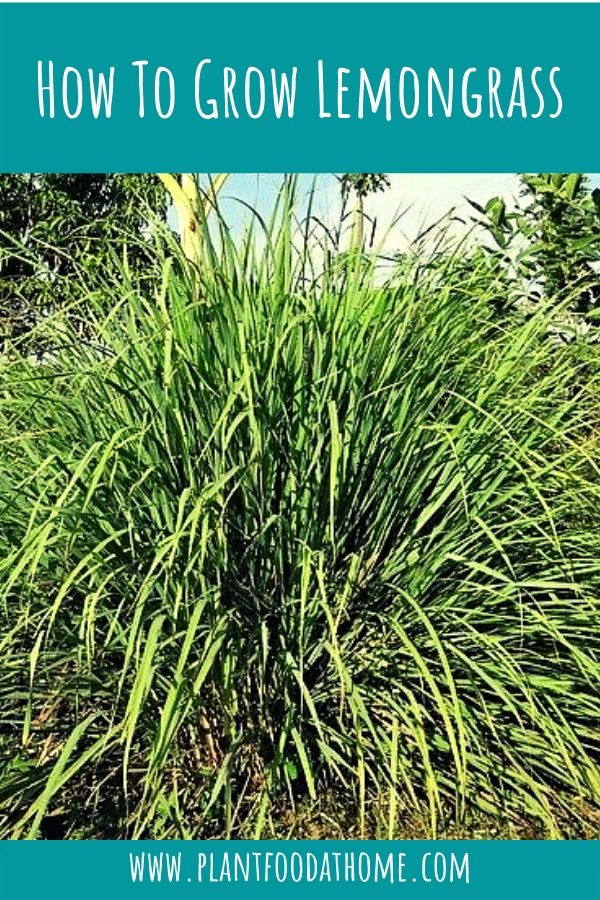
As lemongrass spreads vigorously, consider a barrier when growing directly in the garden such as garden edging, as lemongrass can easily take over.
When growing lemongrass in cold climates, it’s a good idea to grow it in pots or containers to make it easier to move indoors for the winter.
Once the soil is prepared, new lemongrass plants can be planted about 1-2 feet (30-60cm) apart in the garden. Water the lemongrass well and continue to keep the plant watered while it establishes.
Winter will send the plant into a dormant state, even in subtropical climates and this makes an excellent time to prune the lemongrass. In cooler climates, wait for late winter or early spring to prune. Do this by pruning back around 1/3-1/2 off the top of the plant. Pruning will encourage healthy growth in the spring and summer. Pruning is also a good time to give the plant a tidy-up by removing any dead growth and fallen leaves.
Growing Lemongrass In Pots
Lemongrass grows very well in pots and containers. For cool climates, growing in pots or containers is preferable so the plant can be moved indoors during winter.
When selecting a pot size, remember lemongrass is a vigorous grower and can easily spread and fill a pot during the growing season. As lemongrass grows 3-5 feet (1-1.5 meters) high, a pot should be wide and deep enough to accommodate the growth. Consider a pot of at least 5 gallons (18 liters) with good drainage and at least 14 inches (35 cm) wide.
- Prepare your pot or container with quality potting mix amended with compost and well-rotted manure.
- Make a hole in the middle of the pot, plant the lemongrass and backfill the potting mix soil around it.
- Water well and continue to provide adequate water while the lemongrass plant establishes.
- Place it in a bright sunny location.
Once the lemongrass plant has matured, harvest regularly or divide part of the plant at the end of the growing season to ensure the plant has enough room in the pot. Doing neither may result in the lemongrass plant outgrowing the pot and adversely affecting growth.
In cold climates, lemongrass grown in pots and containers can be moved inside the house for the winter into a well-lit position – preferably next to a sunny window. And by placing the lemongrass in an area commonly frequented by the household, the plant will benefit from home heating and the warmer conditions the plant favors.
How To Propagate Lemongrass
There are a few ways to propagate lemongrass; through seeds, cuttings or plant division. Though the easiest and most effective way to grow lemongrass is through plant division from a mature plant.
How To Grow Lemongrass From Seed
Germinating lemongrass seeds need moist warm soil and humid conditions.
If sowing lemongrass seeds in a cool climate, sow them in late winter for spring planting. Otherwise, seeds can be directly planted in the garden in spring.
For winter sowing, use a seed tray with a plastic cover to help provide the humidity favored by lemongrass. Plastic covers can have their vents opened during the day to give ventilation once seedlings emerge and then removed altogether once seedlings are 1 inch high.
A heat mat will provide the ideal temperature for the seeds to germinate. Heat mats will cause the soil to dry so keep an eye on the soil moisture, ensuring soil remains lightly moist.
Finally, consider the amount of light being provided. Seeds require a well-lit environment to germinate. So if growing the lemongrass seeds indoors, place them near a well-lit window or consider grow lights to ensure adequate lighting and successful germination.
- Fill seed-raising pots with a quality seed raising potting mix. These peat pots making make transplanting lemongrass seedlings easy.
- Sow 2-3 lemongrass seeds 1/4 inch deep in each pot.
- Sprinkle soil lightly over the seeds – don’t cover them too heavily under the soil as they need plenty of light to germinate.
- Keep the soil moist during the germination period. Misting with a spray bottle is gentle on the soil, the seeds and new seedlings. Germination normally takes 2-3 weeks.
- When seedlings are about 3 inches (7.5 cm) in height they can be hardened off before being transplanted into larger pots or directly into the garden once night temperatures are consistently above 50° F (10° C).
If multiple seeds germinate in the seed-raising pots, they can be thinned to the strongest seedling. The smaller seedlings can be replanted in their own pot. Alternatively, all seedlings can continue to grow together.
Growing Lemongrass By Division
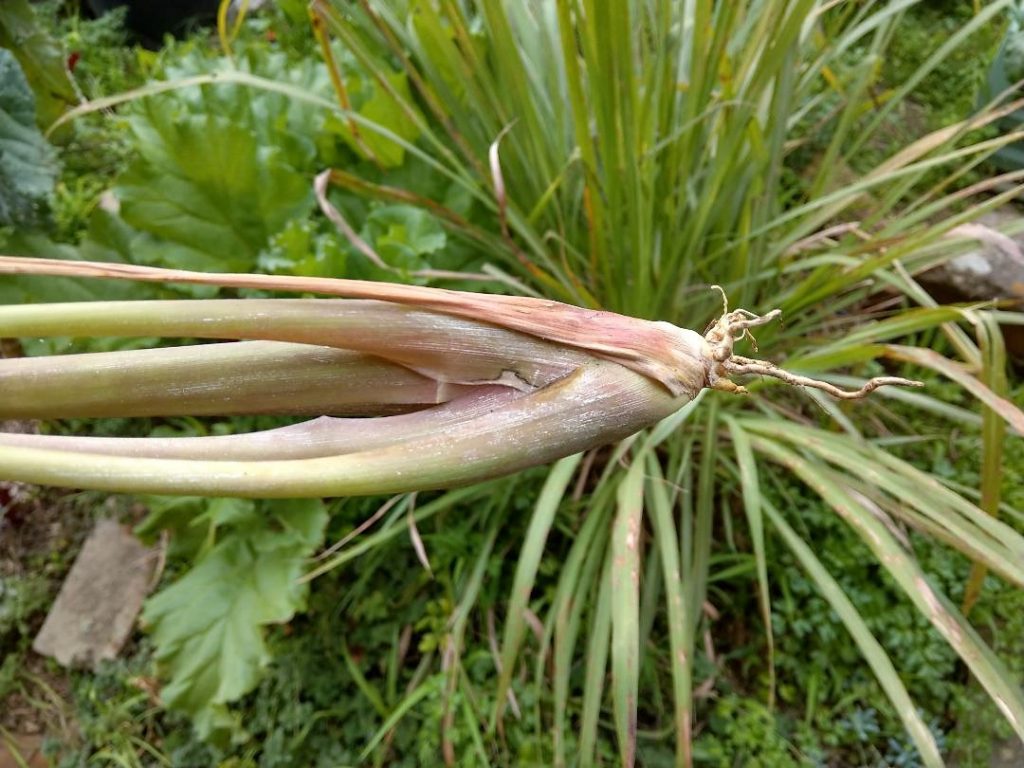
Growing lemongrass by division is the easiest way to have more lemongrass plants. It’s quick, simple and effective because the lemongrass already has established roots. You are simply dividing the plant stalks and replanting them elsewhere.
Take divisions in the springtime.
- Look for a clump with multiple lemongrass stalks.
- Separate the stalks by gently pulling one from the rest of the plant. You may need to use a sharp knife to easily separate them.
- Make sure each stalk has intact roots for replanting.
- Once separated, trim down the grassy leaves to an inch above the stalk.
- Replant the lemongrass directly in the garden or into pots.
- Water new plants well and then continue to water them while the lemongrass plant gets established.
Growing Lemongrass From Cuttings
The easiest way to grow lemongrass from cuttings is to grow them in water, see more below.
Can Lemongrass Grow In Water?
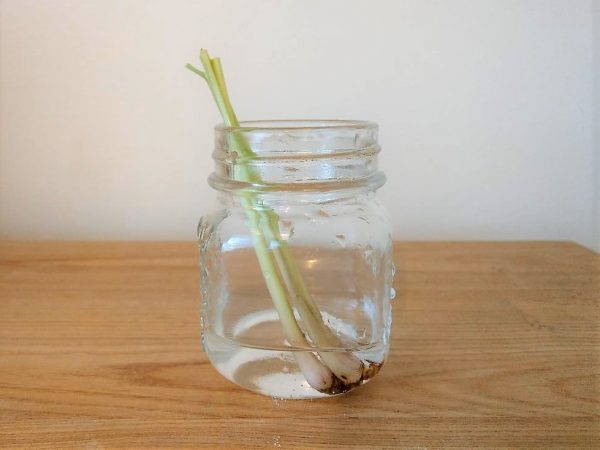
Yes, lemongrass can grow in water. Growing lemongrass in water is a great way to propagate new plants before you plant them in a pot or the garden.
Taking a stalk, start by cutting off the top leaves, about an inch from the stem. Make sure the base of the stalk is still intact for roots to start growing. You may also peel off the outer layer of the stalk.
Then, place the lemongrass stalk – base end down – in a glass with 1-2 inches (2.5-5 cm) of water. Place it on a brightly lit windowsill or a sheltered but bright outdoor position. Change the water every 3-4 days.
In 2-3 weeks, new leaves will start to grow and roots will start to sprout. Let the new lemongrass plant grow a week or two of new root growth before transplanting it into a pot or the garden.
How To Grow Lemongrass From Supermarket
You can grow lemongrass from the supermarket. This is sometimes known as growing lemongrass from kitchen scrapes.
Carefully pick the freshest stalks with a base that is still intact.
If you use the lemongrass for your cooking, reserve about 4 inches (10 cm) of the stalk from the base. Then follow the directions to grow lemongrass in water before planting your new plants in the garden or pots.
How Fast Does Lemongrass Grow?
It takes 3-4 months for lemongrass to reach a size mature enough to begin harvesting. Though it can take a couple more months for the plant to reach full maturity.
Once the lemongrass plant is established it will continue to produce more stalks. In the right growing conditions, lemongrass can grow vigorously and you will have a very healthy supply of lemongrass!
How To Harvest Lemongrass
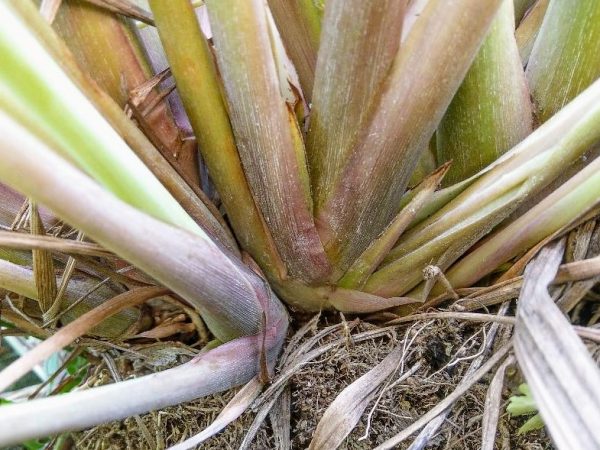
Lemongrass can be harvested once it reaches 12 inches (30 cm) in length and stalks are 1/4 inch (1/2 cm) wide.
Cut the stalks at ground level using a knife or you can hand-pull it by grabbing and twisting the stalk. Take extra care when harvesting as the grassy blades are sharp!
How To Store Lemongrass
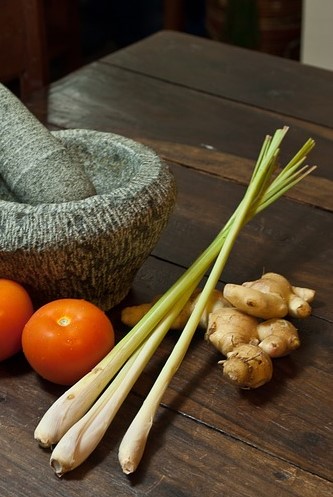
Storing lemongrass in the fridge will last a week or two.
Lemongrass stalks can also be frozen. Cut the stalks to sizes, place them inside a freezer bag or container and put them in the freezer. They are best used within 6 months for optimal flavor but will still keep well beyond this time.
Dried lemongrass stalks and leaves can be stored for a year or so. Cut the leaves and stalks after harvest and lay them on a paper towel until completely dry or use a dehydrator. Place them inside a jar or airtight container and store them in a cool and dark place.
Pests and Disease
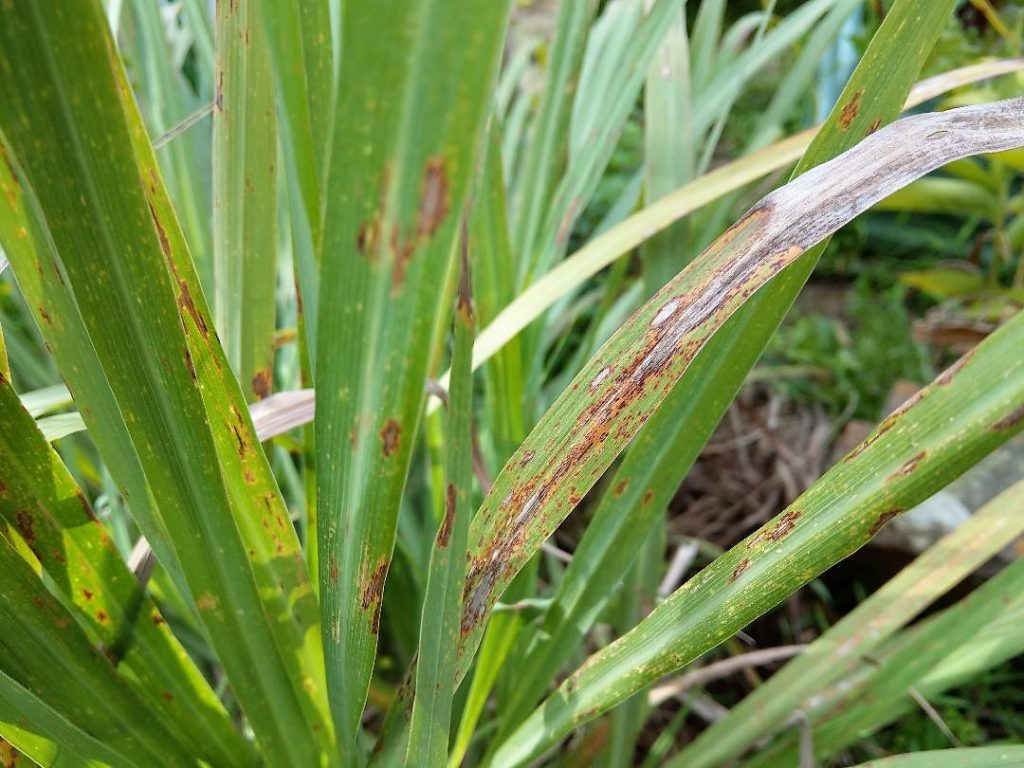
The most common lemongrass disease is called Rust which is caused by fungus. It can cause the leaves to dry out and if not controlled, the plant will eventually die.
Regularly check your plants and underside of leaves to detect this, and remove the affected leaves to allow them to regrow. To prevent this problem, allow adequate space between each plant to ensure airflow, water at the base of the plant and not the leaves, and make sure the lemongrass is adequately fertilized.
Rust can also develop on older plants that have been growing for a number of years. If this is a problem, consider replanting new lemongrass, by division, every 3 or so years.
Aphids are another pest that could cause disease in your lemongrass plant. It feeds on the leaves causing yellow or brown spots. To remove them, blast them off with water or spray them with neem oil.
FAQ
How To Grow Thick Lemongrass Stalks – ensure you choose the right variety. West Indian Lemongrass grows thick stalks. Check the ideal growing conditions favored by lemongrass and allow the plant to grow for a number of seasons for thicker stalks.
Conclusion
Lemongrass is really one of the easiest plants to grow when provided with the right growing conditions. Once established it’s low maintenance and a vigorous producer so you will always have lemongrass available for Asian-inspired dishes and lemongrass tea. Why not give it a try?
Recommended Products
- Lemongrass Plant
- Soil, Light and Water Gauge
- Chicken Pellet Manure
- Liquid Seaweed Fertilizer
- Organic Potting Mix
- Organic Seed Raising Potting Mix
- Seed Raising Peat Pots
- Seed Raising Heat Mat
- Grow Lights
- Food Dehydrator
- Horticultural Neem Oil
Related reading:
- How To Grow Ginger: Guide To Growing Ginger At Home
- Drought Hardy Herbs To Plant At Home
- How to Grow Turmeric and Make Your Own Turmeric Powder
- Why Is My Ginger Plant Dying? Causes and Solutions
- Curry Leaf Plant: Growing, Caring and Eating Curry Leaves
- Is Sugarcane a Fruit or Vegetable?
- Eating Hops And Uses Beyond Beer

